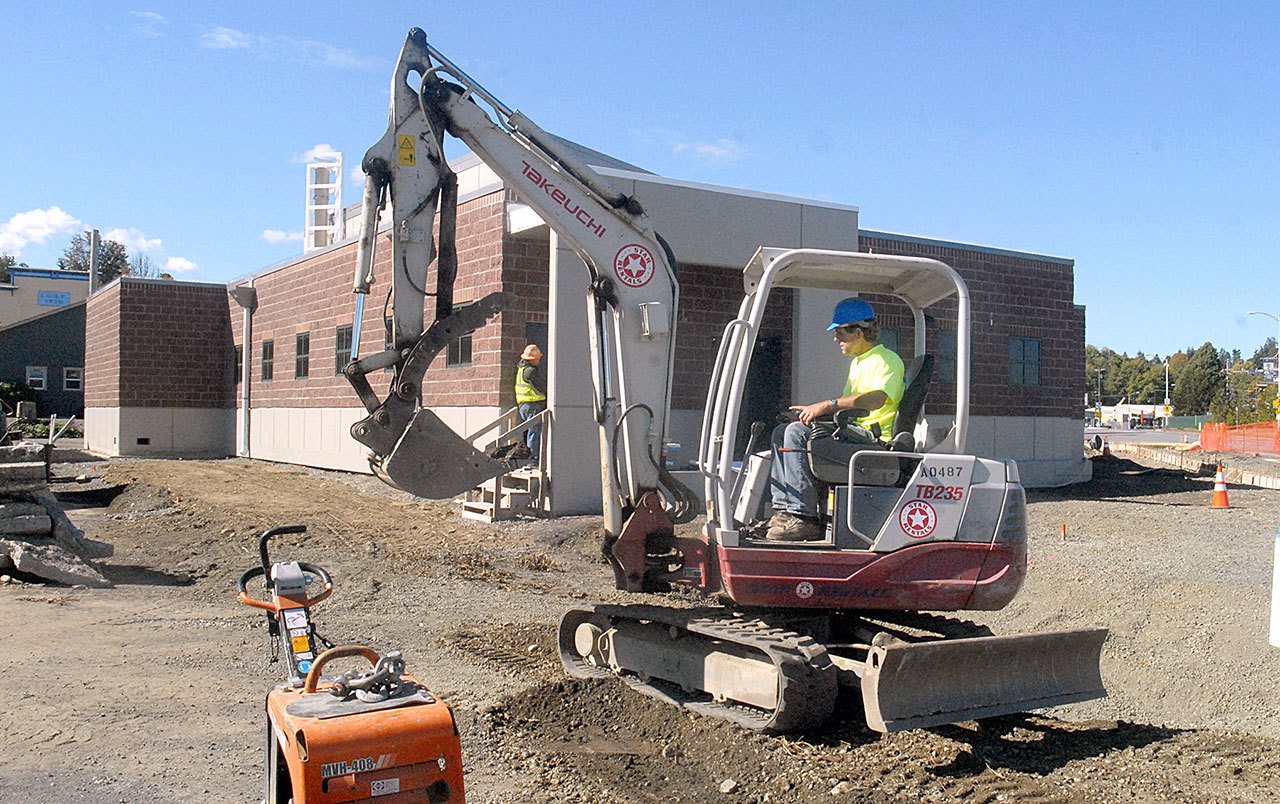PORT ANGELES — This long sliver of a city that hugs its harbor is cleaning up its act.
Just as the rainy season is beginning, workers are putting finishing touches on an effort to stanch the overflow of combined raw sewage and rainwater into Port Angeles Harbor.
It’s the largest public works undertaking in the city’s 126-year history, a legacy tied to the harbor first as an industrial resource, now as a recreational draw with City Pier and the new West End Park.
The $47 million Combined Sewer Overflow project, which went online Aug. 8, is being built under an agreed order with the state Department of Ecology.
The second and final stage will be completed later this fall after landscaping is finished, and alley is paved and an outdated pump station demolished, Public Works and Utilities Director Craig Fulton said Friday.
Paying surcharges
Residential water customers are paying one of two monthly surcharges for a 20-year state Public Works Trust Fund loan to pay for the project, depending on the amount of water customers consume.
Residential customers pay either $19.23 a month, or $230.76 a year, or pay $21.47 a month, or $257.64 a year.
Business customers pay a set base monthly rate of $5.02, or $60.24 a year, plus 0.0172 cents per cubic feet of water consumed.
The improvements will more than double the city’s capacity to pump the effluent to the city’s treatment plant, city Engineering Manager Kathryn Neal said Friday.
She said the goal is to abate the CSO stew that has tainted the harbor.
In 2015, during 75 heavy-rain sewer overflow events, 36 million gallons of sewage-rainwater poured into marine waters .
From 2011-2015, there were 430 discharges resulting in 102 million gallons of CSO pollution gushing into the harbor, according to city records.
Sewage also also came up through manholes, said Gregory Zentner, a municipal operations supervisory engineer for Ecology’s southwest regional office.
“It is a little more of a public health issue than you might think,” he said last week.
The city has four oufalls, each of which will be allowed one overflow event a year under the agreed order, Ecology spokesman Larry Altose said.
The new, 32,000-square-foot pump station that went online Aug. 8 is replacing a smaller, defunct sewage pump station on Front Street just east of Marine Drive at the estuary and just across the street from its more muscular cousin.
The new pump station can pump 28 million gallons a day compared to the 8 million gallons pumped by the smaller station.
All told, the new CSO project can handle a maximum daily flow of 50 million gallons.
Average city flow is 2-4 million gallons a day.
The $25.5 million Phase 1 of the project included new piping and a new 5-million gallon storage tank and outfall the city acquired from Rayonier Inc.
It’s located on the company’s abandoned mill site east of downtown at the harbor’s eastern edge.
“This is very significant, because it’s a huge upgrade to, really, the backbone of the city’s wastewater and conveyance system,” Neal said.
“The wastewater system belongs to every person in the city.”
The new, six-pump facility is a key component of $21.5 million Phase 2 of the project.
Most of the new $15.4 million pump station is sight unseen, housed underground, three stories deep.
The hole was dug with ear-splitting piledriving in spring 2015 that unearthed clam shells far below the surface — but no archaeological finds, city civil engineer Jeff Bender quickly said Thursday during a walk-through of the facility.
“It was a big hole and a big mystery for a long time,” he said.
“Everyone wondered what the big hole was for.”
The 3,200-square-foot building seems antiseptically clean.
A 5-ton hoist hangs from a girder-track on the top floor ceiling.
Its giant hook lifts out ponderous motors and other heavy apparatus for maintenance.
Electrical units on the first floor are tied to three 250-hp motors and three 25-hp motors on the second floor that are tied to six pumps on the third floor.
Motors hum on the second underground floor, where workers have hung a cleaning towel with a Mariners logo on a railing.
Pumps that can push up to 18,500 gallons a minute are on the third floor, more than 40 steps down a metal stairway from ground level.
For a building that collects a steady stream of sewage, only one area emitted a nose-wincing bathroom stench — a room where effluent water flowed openly through a rectangular pit 32 feet below ground level.
Elsewhere, the air smelled clean.
“Carbon media is basically supposed to withdraw the stink,” Bender said.
“We don’t anticipate any odor.”
Completion of the pump station was scheduled for May, but pile driving, and procurement and delivery of sewage pumps, took longer than expected, Bender said.
Change orders added about $170,000 to the original $15.2 million estimated cost of the pump station.
About $100,000 of that covered additional asphalt that was needed to pave Front Street, which suffered from low spots and high cross slopes, Bender said.
Zentner said the completion date for the project is up to the city, though it had been scheduled by December 2015.
But discussions with Rayonier on acquiring the tank took longer than expected, Zentner said.
So did acquiring an outfall from Rayonier that extends far into the harbor, “which everyone agreed was a good thing to do,” Zentner said.
“Ecology was very flexible when it came to when it had to be complete, and we appreciate that from them,” Fulton said.
Port Angeles is one of 11 cities in Washington with combined sewer overflow outfalls, including Bellingham with two outfalls and Anacortes with three.
Seattle has 92.
The outfalls require National Pollutant Discharge Elimination System permits from the Environmental Protection Agency.
________
Senior Staff Writer Paul Gottlieb can be reached at 360-452-2345, ext. 55650, or at paul.gottlieb@peninsuladailynews.com.

